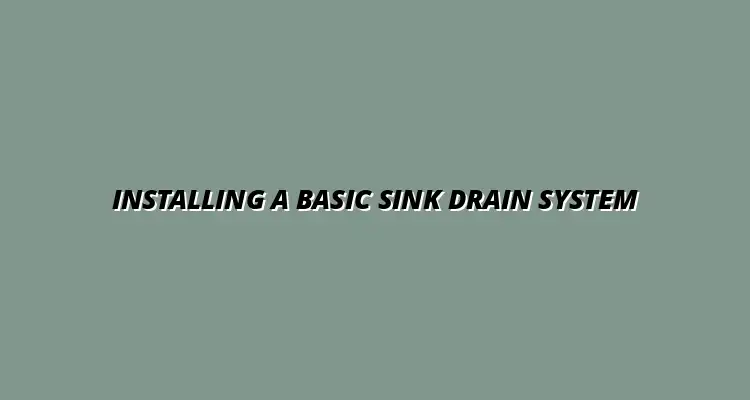
- Beginner Tips
- Dec 29
2025-02-05
Understanding sink drain systems is essential for both homeowners and DIY enthusiasts. A well-functioning drain system is crucial for keeping your kitchen or bathroom free from unpleasant odors and ensuring smooth water flow. With a basic understanding, you can troubleshoot issues and even tackle installation projects yourself! If you're tackling a more complex issue like a leaky kitchen sink, you might find this guide helpful: fixing a leaky kitchen sink.
A sink drain system is designed to transport wastewater away from your sink and into the home's plumbing system. It works on a simple principle: gravity. When you wash your hands or dishes, the water flows down the sink, through the drain, and into the sewer or septic system. Knowing how this system works helps you appreciate its importance in maintaining hygiene and sanitation. Understanding plumbing traps is a key element of this; check out this explanation: understanding plumbing traps.
Different types of sink drain systems exist, including those used in kitchens, bathrooms, and utility sinks. Each has unique features and requirements, but all share the same fundamental goal: efficient wastewater removal. For example, installing a bathroom sink drainpipe is slightly different than a kitchen sink. Learn more about installing a bathroom sink drainpipe here. By exploring these variations, you can select the right system for your needs.
A basic sink drain system consists of several key components, each playing a vital role:
Understanding these components is crucial for anyone looking to install or repair a sink drain system. Each part must be fitted correctly to ensure everything operates smoothly. Regular maintenance, as described in tips for plumbing system maintenance, can prevent many issues.
A properly installed drain system is essential for preventing leaks and clogs. If connections are loose or components are improperly aligned, water can escape, leading to water damage and costly repairs. Additionally, a good installation can prevent the buildup of debris, which often causes slow drainage and unpleasant odors.
Moreover, understanding local plumbing codes is important, as these codes ensure that installations meet specific safety and efficiency standards. When installed correctly, your sink drain system will function well for years, providing peace of mind and maintaining the integrity of your home. For more complex drainage solutions, like a French drain, you can find guidance here.
Before diving into sink drain installation, it's crucial to have the right tools and materials on hand. Having everything ready not only speeds up the process but also reduces the chances of mistakes. Let’s explore what you’ll need!
Here’s a handy list of tools that are essential for your sink drain installation project:
Equipping yourself with these tools will make the installation process smoother and more efficient. If you're struggling with a leaky faucet, fixing it yourself is often easier than you think. Check out these step-by-step instructions: fix a leaky faucet. Each tool serves a unique purpose, ensuring that your sink drain system is secure and leak-free.
Each tool mentioned plays a specific role during installation:
By understanding how to use these tools effectively, you can ensure a successful installation. If you need professional help, you can find a plumber in Billesley, Birmingham, or your local area.
Choosing the right materials is vital for the longevity of your sink drain system. Quality materials can withstand wear and tear, resist corrosion, and ensure efficient drainage over time. Here’s what to consider when selecting materials:
When selecting pipes and fittings for your sink drain system, consider the following:
Choosing the right pipes can mean the difference between a long-lasting installation and frequent repairs. Always opt for high-quality materials that suit your specific needs!
Sealants and adhesives play a critical role in ensuring watertight connections in your sink drain system. Here are some options:
Using the right sealants can help maintain the integrity of your system while preventing future leaks. It’s always better to spend a little more on quality sealants to avoid costly repairs down the line.
When it comes to installing a sink drain system, many people find themselves with questions. It can feel overwhelming at first, but having clear answers can help ease any worries. Here, I’ll address some of the most frequently asked questions that DIY enthusiasts may have.
The time it takes to install a sink drain system can vary based on several factors. Typically, if you have all your tools ready and are familiar with the process, you might complete the installation in about 1 to 3 hours. However, if you run into unexpected problems, it could take a bit longer!
Even seasoned DIYers can make mistakes during installation. Being aware of these common pitfalls can help you steer clear of them. Here’s a list of mistakes to watch out for:
Absolutely! Many homeowners successfully install sink drain systems on their own. With the right tools, materials, and instructions, you can tackle this project confidently. Just remember to take your time and follow each step carefully!
If you encounter any challenges, don’t hesitate to look for online tutorials or ask for help from friends or family who have experience. DIY plumbing can be a rewarding experience that boosts your skills and confidence!
As we wrap up this guide, let’s recap the key steps for a successful installation. This will help you remember what you need to do when you’re ready to get started:
Taking on a DIY plumbing project can be quite a journey! I encourage you to embrace the challenge. With patience and practice, you'll improve your skills and gain confidence in handling plumbing tasks.
Remember, it's perfectly fine to make mistakes. Each project teaches you something new, which is part of the process! So go ahead and give it a shot!
I’d love to hear about your experiences with sink drain installation! Have you tried it yourself? What challenges or successes did you encounter? Sharing our stories can help others feel more comfortable in their own DIY plumbing adventures!
Feel free to drop your thoughts or questions in the comments below! Together, we can learn and grow in our plumbing skills!
